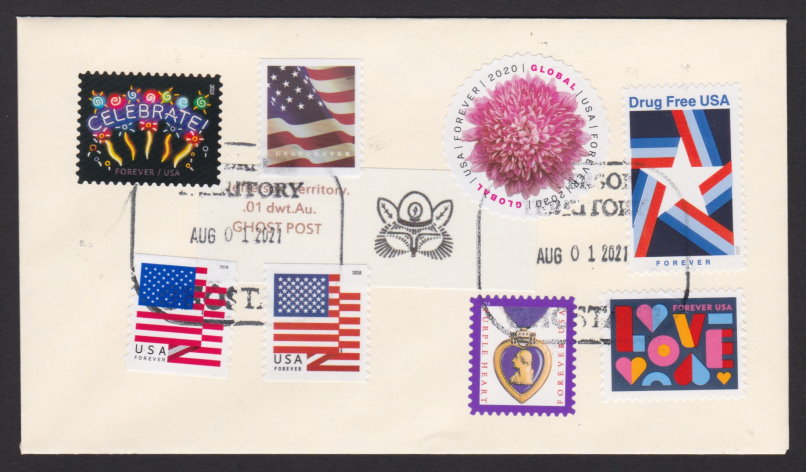Steer clear of discounted Forever stamps
When fellow Local Post Collectors Society member Rusty M. recently sent a few of his local post covers my way, he also included a cover with what at first glance look like common Forever stamps issued over the past several years.
The only problem is that they’re counterfeits. Every one of them.

As you can see, Rusty has wisely canceled the stamps with his Jefferson Territory postmark to ensure they can’t actually be used. He has spent a ton of time looking for modern postal counterfeits, and sadly enough, he has found plenty.
Postal counterfeits go back a long way. The first ones to be produced in the United States showed up in the late 19th century! Those early counterfeits were generally not very dangerous since the genuine article was engraved and the counterfeits were not, but at any rate, this is not a new problem.
It is, however, a big problem for the United States Postal Service. The things have become so common that I received one on a cover in 2019, and found one in the recycle bin at the post office earlier this year, and then received two more on covers from a collector! My guess is that collector didn’t even realize the stamps he was using were not legitimate.
I don’t receive a ton of mail with stamps on it, and most of the stamps I do acquire are the nondemoninated nonprofit stamps used on fundraising solicitations. If I’m finding counterfeits on my incoming mail, they have to be common.
Some of these modern postal counterfeits are pretty easy to spot. A couple of the flag stamps on Rusty’s cover, for example, look wrong and feel wrong. Many are much more convincing, and some look so close to the real thing that it’s only under high magnification that inconsistencies appear. The print quality and accuracy of the die cutting is good enough that the counterfeits must be the products of a professional operation; they’re not simply copies that people are running off their inkjet printers at home.
You’re most likely to get hold of a batch of counterfeits by buying from various online sellers advertising recent coils or sheets of Forever stamps at less than face value—sometimes much less than face value. Some of those offers may be legitimate, but ask yourself this: why would someone sell Forever stamps at less than face value? 3¢ and 5¢ stamps of years gone by? Sure; collectors saved huge numbers of those, and they’re not very convenient to use. But Forever stamps don’t have that drawback. A Forever stamp has the same value it did when it was purchased: it pays the cost of mailing one letter.
With that in mind, I invite you to join me in steering clear of online ads for Forever stamps at less than face value unless you’re buying from a reputable, established stamp dealer who’s willing to guarantee that the stamps are legitimate. Otherwise, buy your Forever stamps from your local post office or via the official USPS website; that’s what I do, and I can be far more confident that I’m getting the real deal and not getting ripped off or inadvertently defrauding the USPS by using counterfeit stamps. No, it won’t stop other people who aren’t aware that they’re buying counterfeits from putting money in the countefeiters’ pockets, but at least we won’t be contributing to the plague.
Published 2022-12-06
Comments
Log in or leave an anonymous comment.